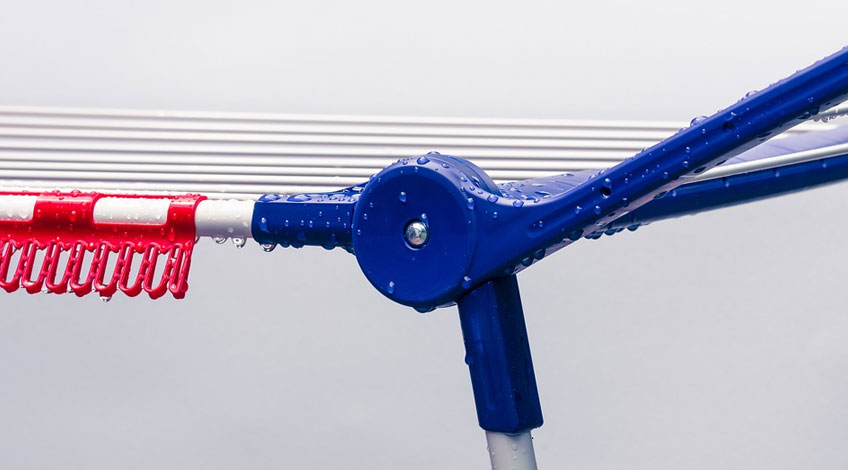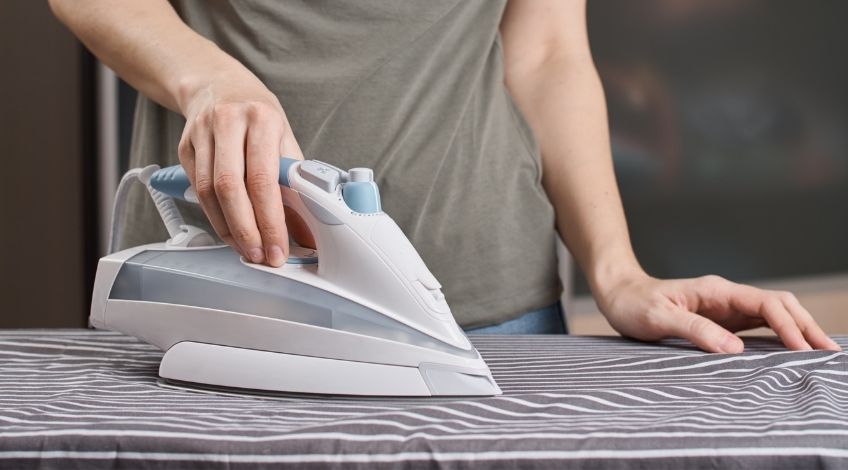
How To Dry Bedding Indoors (quick way to dry your sheets)
We all know that we should change our bedding regularly (experts say sheets, pillow cases and duvet covers should be changed ideally once a week or at the very most every fortnight). During the warmer, dryer parts of the year, this is easy, but when it’s wet and cold drying bedding can become a challenge.
If you’re looking for the best way to dry your bedding indoors in as short a time as possible, keep reading. In this article we look into the best ways to get bedding dry indoors.
As well as offering some helpful hints and tips to give you the best chance of keeping your home free from that musty, damp smell associated with drying large items indoors.
The Best Ways To Get Bedding Dry Indoors
Let’s get straight into the best ways to dry bedding indoors when the weather is too bad for outdoor drying. We’ll start with the most obvious which is;
Dry Your Bedding In The Tumble Dryer

- SENSOR DRYING SYSTEM - Sensor drying system uses sensors to monitor moisture and temperature levels inside the dryer and automatically stops when it reaches the chosen level of dryness you require. ((Note: This model does not have a Reverse Spin Action)
- ONE TOUCH TECHNOLGY - This appliance is equipped with One Touch Technology which allows you to control, download new cycles, discover tips via an App, on Android smartphones with NFC connectivity. For other Android devices and iOS operating systems, the App gives access to information only.
We realise that if you are reading this article it’s probably because you either don’t have a tumble dryer or don’t want to use it for some reason. But we wouldn’t be thorough if we never covered all of the available options.
Before tumble drying your bedding, check the wash care label for specific washing and drying instructions. Once you have selected the correct setting for your bedding, it should only take somewhere between 45 to 60 minutes to get them dry.
Tip: Place wool dryer balls in the dryer with the bedding to help speed up the drying process.
Use An Airer To Dry Your Bedding

- 𝐒𝐓𝐔𝐑𝐃𝐘 & 𝐒𝐋𝐄𝐄𝐊 𝐃𝐄𝐒𝐈𝐆𝐍: Elevate your laundry routine with our foldable clothes airer. This sturdy and stylish clothing drying rack features a durable stainless steel finish, offering 18 meters of drying space for a full load of laundry.
- 𝐒𝐏𝐀𝐂𝐈𝐎𝐔𝐒 𝐃𝐑𝐘𝐈𝐍𝐆 𝐀𝐑𝐄𝐀: Our large clothes airer includes 22 bars, providing a generous drying area for all your clothes, towels, and sheets. Ideal for anyone needing a reliable indoor airer for multiple loads or larger washes.
If you live in the UK and have lots of laundry to dry through the winter months, you probably already own an airer. Placing an airer in a well ventilated room in front of a radiator is a great way to get laundry dry.
You’ll need to spread your bed sheets/duvet covers over the airer in such a way to allow maximum airflow. You’ll also need to distribute the weight of the bedding evenly to ensure the airer doesn’t fall over.
Tip: Place a dehumidifier or fan in the same room as the airer to help reduce moisture and speed up the drying time.
Invest In A Heated Airer To Dry Bedding
- Heated Clothes Drying Rack: Heated clothes airer saves energy and is a great way to dry clothes indoors. Just plug it in, and the heating wand gently heats up to dry wet clothes quickly and easily. There are 18 drying bars including heated wings for extra drying space
- Foldable and Portable: No installation is required; just open it and use it. After use, fold the stand to complete the storage and place it in the corner without taking up space.
Heated airers are almost identical to regular airers except they heat up via an electric element that will get your bedding dry even faster. Many heated airers are supplied with a cover that keeps heat and moisture contained.
Heated airers tend to be quite tall and can accommodate around 15 kg of laundry. Which is more than enough for drying bedding.
Tip: If your heated airer doesn’t have a cover you can use a large towel or bed sheet to cover the drying bedding.
SEE ALSO: How Long Do Heated Airers Take To Dry Clothes?
Dry Bedding On A Door
Although not ideal, it is possible to drape your bedding from an internal door in your home. This can be the door to a room or even a wardrobe door.
The room needs to be well ventilated and using a dehumidifier is recommended if you intend drying bedding over a door.
Tip: Take care that the wet bedding doesn’t damage the door. A safer option is to use a few coat hangers to attach your bedding to the door so that the bedding isn’t actually touching the door.
Dry Your Bedding On A Bannister
If you have a bannister over the landing in your home, you can drape your bedding over it and allow it to dry. As with the door, take care to not allow the wet bedding damage the wooden bannister.
The best way to avoid this is to use hangers to keep the fabric off the wooden surface.
Tip: Ensure the area is well ventilated by opening a window and placing an electric fan aimed directly at the bedding.
Use An Indoor Retractable Clothesline
- Space-saving compact pull-out clothes line
- Smooth pull-out system and automatic blocking ensures the lines are always taut. Easy to fix between two walls
If you have a room that isn’t used often, you could install a retractable clothesline to dry your bedding. Retractable clotheslines are attached to a wall and the line is extended onto an opposite wall while it is needed to dry laundry.
Once the laundry is dry, the line is retracted and the room can be used as normal.
Tip: Ensure the room is well ventilated and place a dehumidifier in the room to reduce the moisture content and speed up the drying process.
Dry Your Bedding In The Airing Cupboard
If you have an airing cupboard where the water heater is, you can hang your bedding in there to dry. This can save you money as you are utilising heat that’s been created anyway and is not on specifically to dry laundry.
Leave the airing cupboard door open slightly to allow adequate ventilation and prevent damp and mould.
Tip: Use two or more hangers with clips to hold the bedding and hang them inside the airing cupboard.
Use The Shower Rail To Dry Bedding
If you have a shower in your home, you can hang your bedding on the shower rail to dry. You will need to open the window to improve ventilation in the room and use the extractor fan as well.
Hang the bedding from hangers and place the hangers on the shower rail to allow them to dry.
Tip: Ensure the shower rail is sturdy enough to take the weight of the wet bedding.
Dry Your Bedding In The Garage
If your home has a garage, you can hang your bedding from a retractable clothesline or a makeshift washing line suspended between two joists.
It might take longer to dry bedding in an unheated garage, but it keeps that excess moisture from your home.
Tip: A good way to reduce moisture is to place a dehumidifier in the garage while drying your bedding.
Use An Iron To Dry Your Bedding

- The 2 metre long power cord is ideal for ironing larger items
- Self-cleaning makes cleaning easier
It is possible to help dry your bedding faster by ironing it dry. You will need to consult the care label to see if the fabric your bedding is made from can be ironed. Generally the following fabrics can be ironed; cotton, linen and denim. If the sheets are made of the following, it might not be a good idea: silk, wool, polyester, spandex, heat resistant fabrics and water resistant fabrics.
Tip: Make sure the fabrics are nearly dry before ironing, otherwise you will struggle to iron dry them. They should only be damp to successfully iron them dry.
SEE ALSO: Can You Dry Clothes With An Iron?
Use A Radiator Rack To Dry Your Bedding
- DRY MORE CLOTHES - There are five rails on the drying rack so you may hang your laundry from them to dry more things at once. Improve your efficiency and hasten the drying of all of your family's clothes. This radiator airer is quite useful because it works well for airing out and drying towels and apparel. This clothesline is sturdy enough to handle your dirty clothing while remaining lightweight enough to avoid scratching any vertical surfaces you hang it from, such a door, radiator, or other.
- SPACE SAVING AND 5 HANGING BARS - This item has a modern, high-end design that is both beautiful and well-made. Useful and transportable for usage in various places throughout the house or trailer. easily cleaned with a moist towel or duster. Improve your laundry efficiency to hasten the drying process. The Straame radiator rack is the ideal accessory for any hectic lifestyle.
We do not recommend this method as it can lead to all manner of problems associated with damp. Mould and mildew breed rapidly in damp conditions and drying bedding on a radiator creates the perfect conditions for mould spores to grow.
At least with a rack the bedding can get some airflow, but it’s still not an ideal solution and should only be used as a last resort in an emergency.
Tip: Ensure the room is well ventilated by opening a window and placing a dehumidifier in front of the drying bedding to absorb moisture.
Dry Your Bedding At The Launderette

If you really don’t have anywhere at home to dry your bedding, you might have to resort to using the dryer at the launderette. We know this isn’t at home but using a launderette is technically indoors.
There is a cost involved but as the dryers at launderettes are larger than those found in the average home, you’ll be able to dry a full wash load all at the same time.
Tip: Most areas have a launderette and performing a quick online search should locate your nearest one.
How To Speed Up Drying Times
There are a few ways to increase the rate your bedding dries at. These include;
- Giving Bedding An Extra Spin
Once the washing machine has completed its cycle, run your bedding through another spin cycle. This will remove even more moisture from your bedding and speed up the drying process. - Using An Electric Fan
Whichever way you choose to dry your bedding indoors, aiming an electric fan to blow moisture away from it as it dries will speed up the drying process. Fabrics dry by releasing water molecules into the dryer air around them. By removing the damp air and replacing it with dryer air, you will find your bedding dries faster. - Using A Dehumidifier
Dehumidifiers work by removing moisture from the air. This allows more moisture to be released from the fabric at a faster rate. - Use A Hairdryer
Once your bedding is hanging from an airer, bannister, shower rail, radiator rack, retractable clothesline etc, you can speed up the drying time by blasting it with a hairdryer. Be sure to keep the nozzle at a distance of at least your clenched fist away from the fabric and ensure the nozzle is continuously moving. Never let the hot air stay in one area for too long to prevent scorching.
SEE ALSO: Dehumidifier Vs Tumble Dryer For Drying Clothes: which is better?
How Often Should Bedding Be Changed?

Bedding needs to be changed regularly to remove sweat and dead skin cells. Even though we sweat more during those hot summer months, even in winter bedding should be changed and washed once a week.
If this isn’t possible, you should wash your bedding at least every fortnight.
How Often Should Bedding Be washed If You’re Sick?
If you are caring for a sick person, their bedding should be washed daily in an ideal situation. If this is too much, you should at least change the pillowcase daily to prevent the spread of germs and viruses.
Can Not Washing Bedding Cause Illness?
If you don’t wash your bedding regularly, you create the perfect environment for dust mites to breed. Dust mites feed on dead skin cells which are shed from the human body while we sleep.
Asthma sufferers and those with breathing complications are more susceptible to problems related to dust mites.
How Often Should Bedding Be Replaced?
If you own good quality bedding, it should last for anywhere between 5 to 7 years. However, if you spot any signs of wear and tear you should replace your bedding.
Egyptian cotton and linen bedding is far more durable than many other fabrics and will last longer. Plus 100% Egyptian cotton and 100% linen will get softer after every wash.
Does New Bedding Need Washing Before Use?
Although not everyone agrees, we recommend washing new bedding before use. The new bedding might look clean but it could be covered in chemicals from the manufacturing process.
While you might not be sensitive to any of the chemicals used when the bedding was made, it’s not really worth taking a chance. Plus, washing the bedding before use gives you a chance to check on the condition.
This means you’ll be more likely to notice any faults or defects in the bedding and will allow you enough time to return it to the store you bought it from.
SEE ALSO:
Frequently Asked Questions
You can dry sheets quickly indoors by using a tumble dryer, hanging them in an airing cupboard, on an airer or heated airer, on a door, over a shower rail, on a bannister, or on a radiator rack. To speed up the drying process you can use a dehumidifier and an electric fan.
Drying sheets in the winter can be done by using a tumble dryer, a heated airer, indoors retractable clothesline, radiator rack, by hanging them over the shower rail, in an airing cupboard, on a bannister, or in a garage.
Ideally bedding should be washed every week or at the very least once a fortnight. If the bedding was taken from an ill person’s bed, it should be washed daily.
Also, follow us on Pinterest ...









